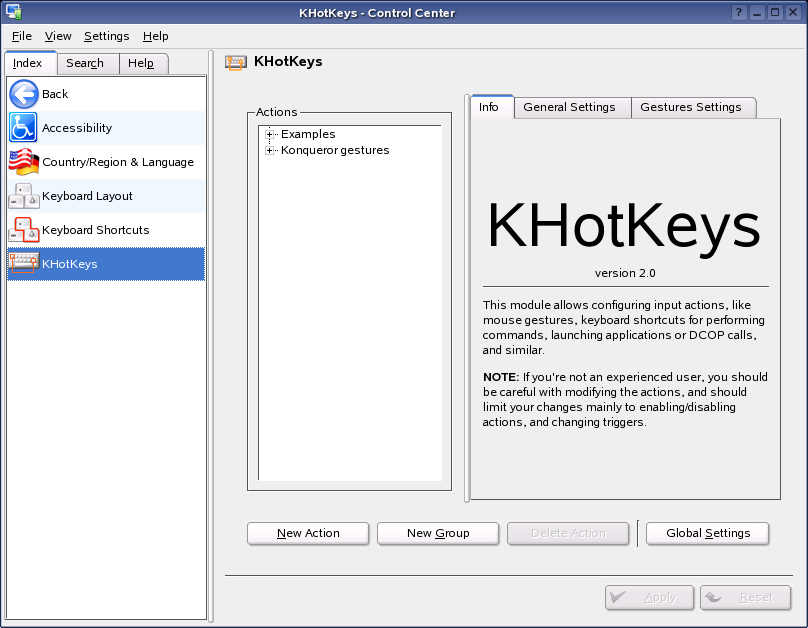3.7 Regional & Accessibility Settings
Use the settings under the Regional & Accessibility category to configure options to do with region and locale, and also accessibility-related options for disabled persons.
3.7.1 Configuring Accessibility Settings
Click .
This module facilitates access to the system for users with hearing problems or motor disorders. This module contains the and tabs.
Figure 69 KDE Control Center Accessibility Dialog
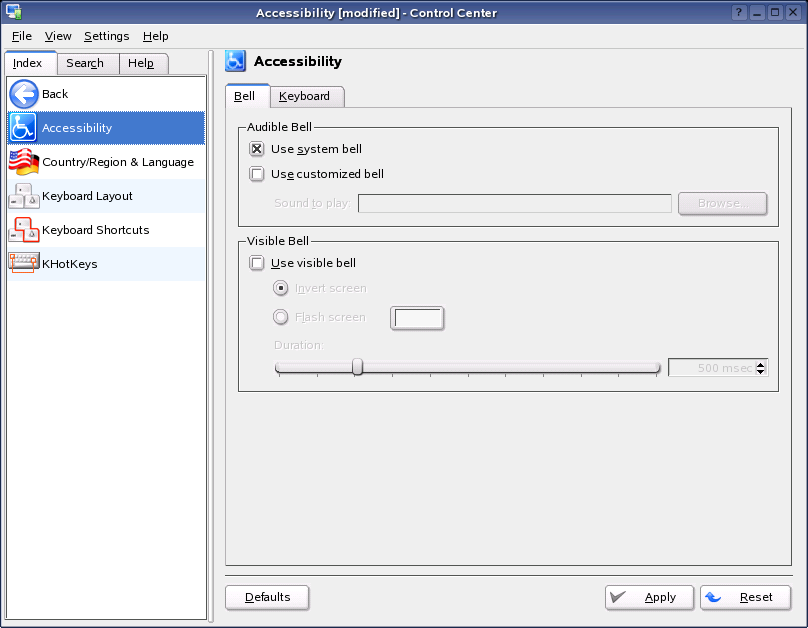
The options in this dialog include:
-
Audible Bell:System bells can be communicated to the user in a visible or in an audible form. The default setting is the audible variant with . To configure a specific sound, activate and then use to select a suitable sound from the list.
-
Visible Bell:For system bells to be communicated visually, activate . If no other modifications are performed, the screen is inverted when a system bell rings ( is activated by default). The duration of the visual bell can be adjusted with the slider. Instead of the inversion, the screen can be set to flash. To do this, activate and then select a suitable color in the color editor by clicking the color bar.
-
Sticky Keys:Some shortcuts require a key to be held down (this is the case with Alt, Ctrl, and Shift) while the second part of the shortcut is entered. If sticky keys are used, the system considers these keys to be pressed continuously even if they are pressed only once.
-
Slow Keys:Determines if and to what extent the system delays the output of characters on the screen when a key is pressed. The longer the interval adjusted with the slider is, the longer a key can be pressed without triggering a repeated output of the respective character on the screen.
-
Bounce Keys:If you activate this option, pressing a key twice is interpreted as two characters only if the interval selected with the slider has elapsed. If a key is pressed twice inadvertently, this is ignored.
3.7.2 Configuring Country, Region, and Language Options
Click .
This module lets you configure options that are specific to your location, such as language, currency, and the date format. The settings in this module apply only to KDE applications. Other applications, such as OpenOffice.org, might need to be configured separately.
Figure 70 KDE Control Center Country/Region & Language Dialog
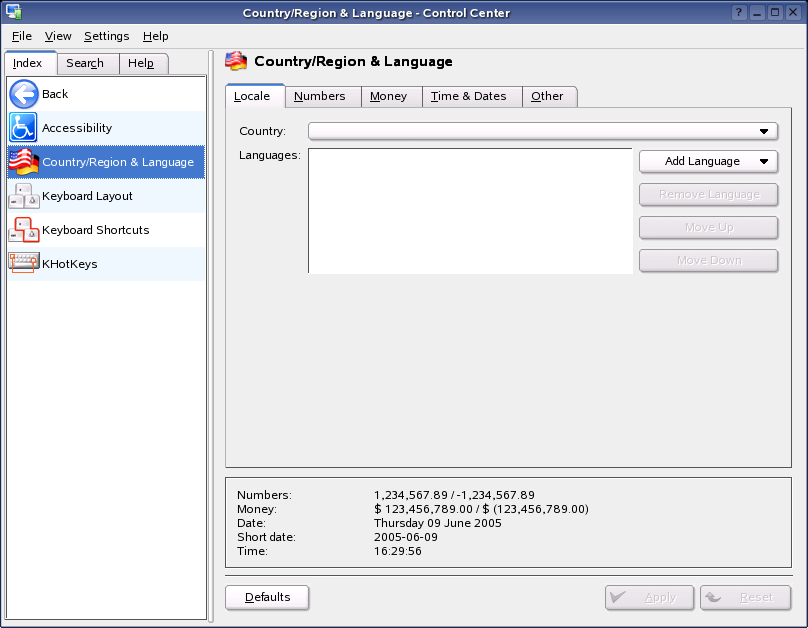
All regional system settings can be configured using these five tabs:
-
Locale: Use the drop-down menu to select the desired country from the list. Settings such as the language, numbers, currency, time, and date are automatically set to suitable values. A preview of all current regional settings is displayed at the bottom of the page. For example, to use the regional settings for the U.S. but use Spanish as the system language, click Add Language to select this language and add it to the list of available system languages. To remove a language, select it from the list and click Remove Language.
-
Numbers: To use different number settings than the default settings associated with the country selected under Locale, configure the decimal symbol, thousands separator, positive sign, and negative sign. The decimal symbol and the thousands separator for currencies are configured separately on the Money tab.
-
Money:Configure all currency-related settings that should differ from the default settings for the selected system language. The position of the currency symbol and the prefix for positive and negative amounts are arranged in such a way that the currency symbol precedes the prefix and the amount.
-
Time & Date: Sets the time format, date format, short date format, and first day of the week.
-
Other:Sets the default paper format and measurements. On a U.S. system, the default paper format is US Letter and the imperial system is used for measurements.
3.7.3 Configuring Keyboard Layouts
Click .
Use this module to configure Kxkb, a keyboard layout switching utility that uses the X Window System* xkb extension. It allows you to switch between different layouts using a tray indicator or a keyboard shortcut. You can enable/disable keyboard layouts through this dialog, and add more. Some of the more powerful features are the ability to configure switching of layouts globally, per application or per window.
Figure 71 KDE Control Center Keyboard Layout Dialog
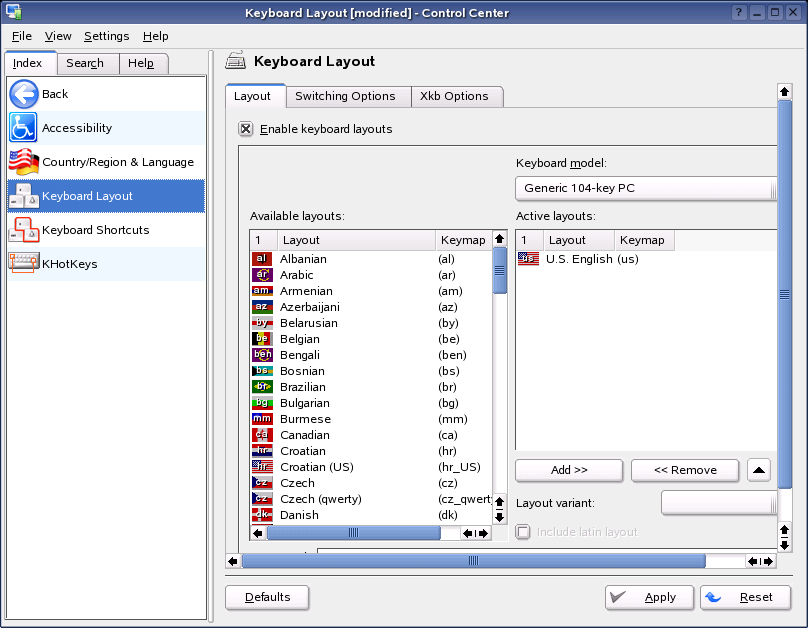
For more information, see Configuring Basic Keyboard Settings and Configuring Keyboard Shortcuts.
3.7.4 Configuring Keyboard Shortcuts
Click .
Use this module to configure global KDE keyboard shortcuts. There are several predefined shortcut schemes you can use if you are more used to another windowing environment, such as Windows or Macintosh. If you prefer, you can customize your own scheme and modifier keys.
Figure 72 KDE Control Center Keyboard Shortcuts Dialog
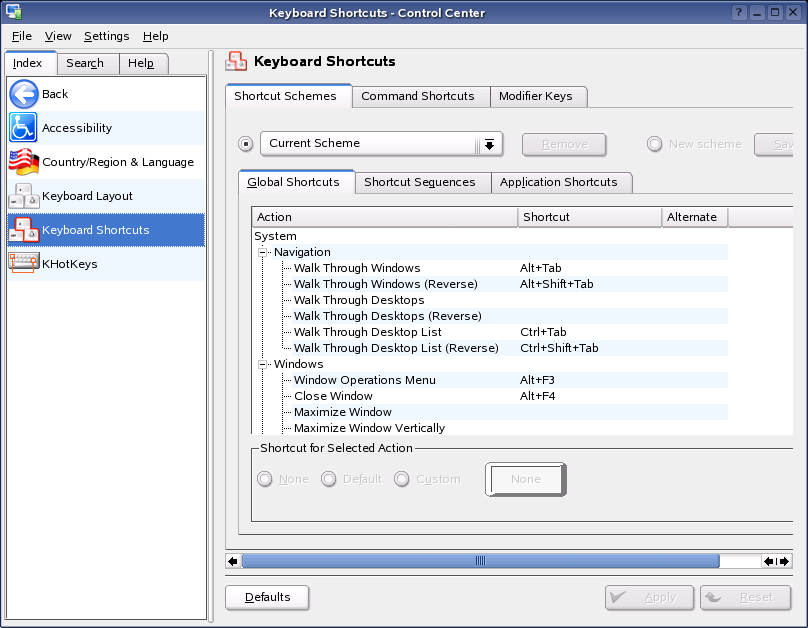
Use to select an existing layout or create new keyboard layout schemes. provides an overview of the special keys available on your keyboard.
Your system offers a number of predefined shortcuts for specific tasks arranged in schemes. Use to manage all shortcuts on your system. By default, the following schemes are available on your system:
- Windows Scheme (With Win Key)
- Mac Scheme
- KDE Default for 3 Modifier Keys
- Windows Scheme (Without Win Key)
- KDE Default for 4 Modifier Keys
- UNIX Scheme
To change the scheme used on your system, select one of the listed schemes and adopt it globally (, , and ) or assign shortcuts to individual actions and save them as a custom scheme.
To create a new shortcut for an action or modify an existing shortcut, click the tab for the respective area (for example, Global Shortcuts) and then click the action to assign (for example, ). The section is then activated at the bottom of the page. Three radio buttons offer the basic configuration options of , , and .
Existing schemes are write-protected, allowing restoration of the default values at any time. Save your own modifications by clicking at the top right and specifying a name for your custom scheme. The new scheme is then listed in the selection menu.
HINT: Under Application Shortcuts, you can configure only standard actions available in all applications. Program-specific shortcuts must be configured in the program itself.
For more information, see Configuring Basic Keyboard Settings and Configuring Keyboard Layouts.
3.7.5 Configuring Input Actions
Click .
Use this module to configure input actions, such as mouse gestures and keyboard shortcuts, for launching applications and running commands.
Figure 73 KDE Control Center KHotKeys Dialog
